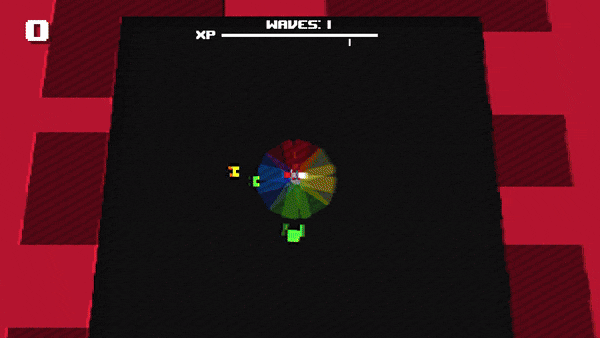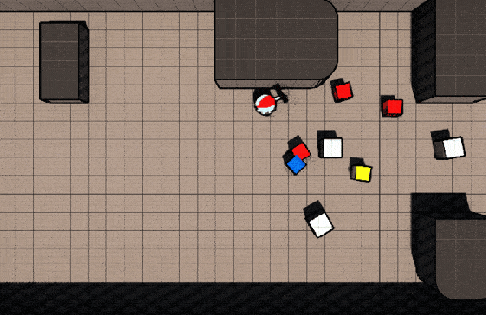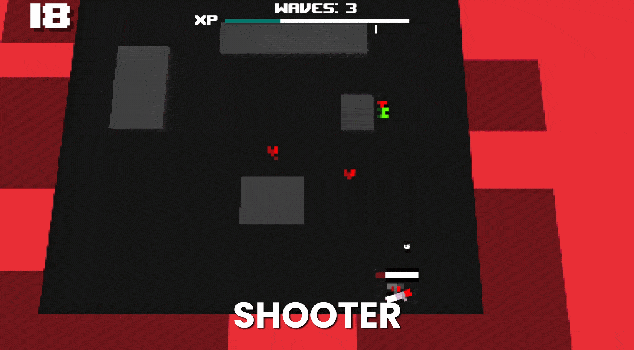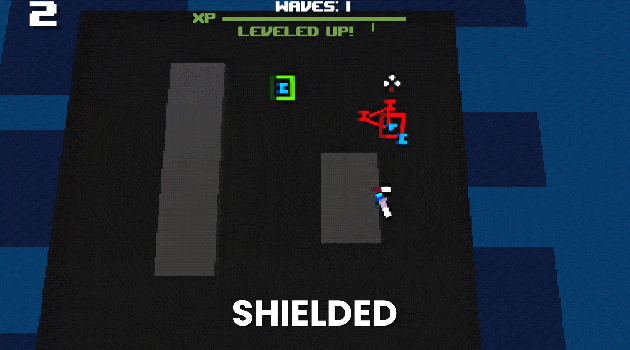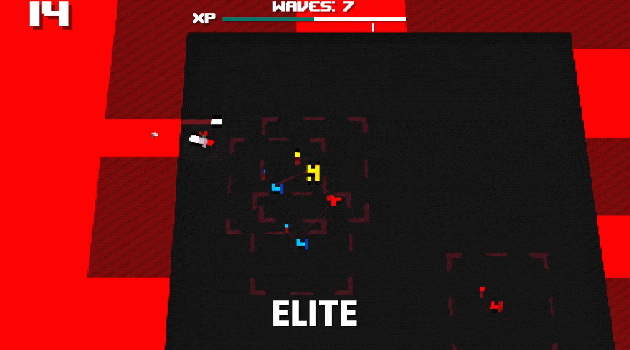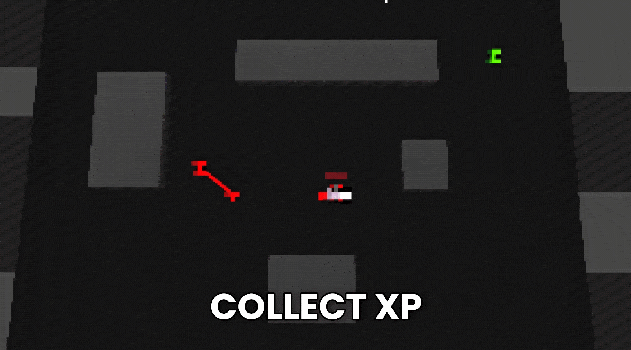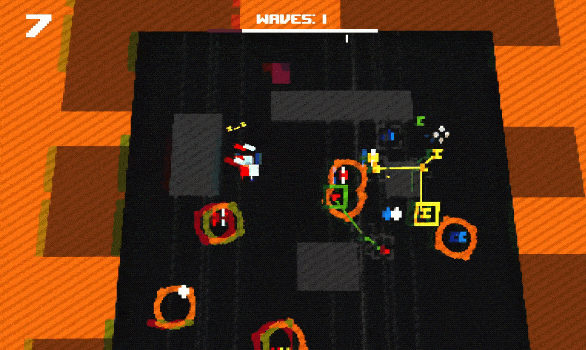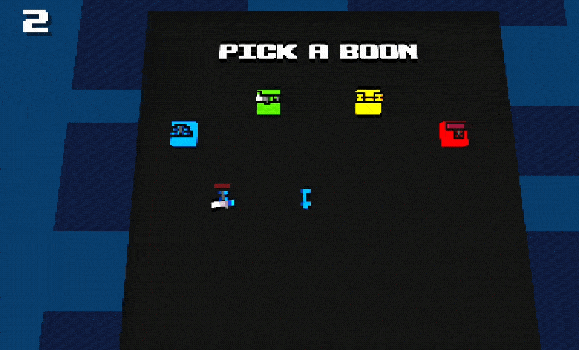
MATCH 3 ROGUE
GAME DESIGNER. TECHNICAL DESIGNER.
Satisfying and energetic ROGUE-LITE TWIN STICK SHOOTER where your weapon spawns enemies. MATCH 3 to destroy them. Combat hoards of enemies to acquire game-changing items and reach a high score.
-
GENRE: Rogue-Like/ Twin-Stick Shooter
TEAM SIZE: SOLO
PROJECT TIMELINE: 8 Weeks | 2023
ENGINE: Unreal Engine 5
-
Designed and implemented core gameplay loop, involving twin-stick combat and match 3 system.
Designed and implemented 16 unique enemy types with design pillars of simplicity and target prioritization.
Designed and implemented onboarding and difficulty progression.
Designed and implemented reward systems and meta-progression, including 16 unique upgrades and item synergies.
Designed and implemented UI/UX.
Informed design decisions via process of playtesting and iteration.
DESIGNING CORE GAME LOOP
WHAT
As a solo project, I generated the initial game concept and designed an engaging core loop. An effective foundation on which to build.
The game’s core conceit involves merging twin-stick shooting with match 3 mechanics. The act of avoiding and executing enemies in a twin-stick context is enhanced by the satisfaction and strategy present in match 3 games.
The player can perform 3 key verbs: dash, shoot, and match.
Each play into the other. Dash to select your color, shoot to generate new enemies of that color, and match enemies to complete the loop.
CORE LOOP IN ACTION
EARLY DESIGN BREAKDOWNS
Following a bottom-up approach to ideation, “following the fun,” the target player experience was defined: Satisfaction, Mastery/ Strategy, Easy to Learn.
HOW
Pre-production, prototyping, in-engine implementation, and consistent playtesting and iteration enabled the design and development of the core loop.
RESEARCH
SKETCHING/ IDEATION
Performed preliminary research and ideation to explore opportunities with the project deliverable’s target genre: twin-stick shooter. Insights were gained from existing games, observing smaller titles given the 8 week deadline.
PROOF-OF-CONCEPT PROTOTYPE
Prototypes were rapidly produced within Unreal Engine 5, allowing me to validate concepts and the game’s core loop.
TECHNICAL IMPLEMENTATION
Game content was implemented using Blueprints within Unreal Engine 5, including the snippet of the player character above.
PLAYTESTING & ITERATION
Consistently informed and validated changes to the core loop based on feedback from playtesters.
E.g.
Matching was performed automatically. This was altered in later iterations following an AB test. Playtesting feedback confirmed that giving agency over when enemies matched better aligned with the target player experience. It was more satisfying, created further room for strategy and mastery, all without undermining the game’s ease of learning.
This included in-engine experimentation, attempting to perform matches via a button within the play space before opting for a more conventional controller input.
WHY
FOLLOWING THE FUN
Early prototypes revealed a fun set of player interactions. Each player verbs involves a distinct advantage and disadvantage. I.e. shooting creates matches, but also creates enemies.
Moving from a bottom-up to a top-down design approach, a target player experience was defined based on and to help retain the core “fun.”
E.g.
Interlocking Dash & Color Selection: Choosing where to dash or what color to pick are decisions of their own, but forcing an overlap added a layer of depth that was appealing.
PLAYER EXPERIENCE
Design decisions aimed to target the game’s core pillars.
SATISFACTION
Player verbs, like matching enemies, should feel satisfying to perform. Interacting with the game, objective aside, should feel nice.
MASTERY/ STRATEGY
Achieving the player’s goal should take skill and effort, pushing players to play again and again, getting better each time.
EASY TO LEARN
Core gameplay should feel intuitive. Even if getting good takes effort, knowing where one can begin improving is key.
DESIGNING ENEMIES
WHAT
Designed and developed numerous enemies with color-matching properties that attack the player as a horde. Enemies vary in movement patterns, unique properties, or some combination of the two. Enemies spawn in waves, increasing in frequency and intensity as players progress.
Brief rundown of all 16 enemy types.
COMMON ENEMY PROPERTIES
E.g.
SHOOTERS fire enemies, acting as longer ranged threats and spawners if not dealt with. Emphasizes target prioritization.
EXPLODERS detonate when matched, damaging the player and all nearby enemies. Adds additional risk-reward gameplay.
HOW
Sketches, prototyping, iteration and a solid technical foundation were integral for the rapid development of numerous enemy types.
SKETCHING/ IDEATION
A variety of simple enemy types were concepted, often sketched in greater detail when faced with design questions.
RAPID PROTOTYPING
Rapidly prototyped enemy types, observing their impact on the core loop, particularly in relation to other enemy types within a horde shooter context.
TECHNICAL IMPLEMENTATION
Implemented wave system, such that enemies spawn in either consecutive or overlapping waves, increasing in frequency and intensity as the player progresses.
Implemented enemy matching system, utilizing interfaces, to enable the game’s USP. As such enemies can match with and through nearby matches.
Implemented a gym for testing enemies.
Used blueprints and behavior trees to implement numerous enemy behaviors.
PLAYTESTING & ITERATION
Iterated upon existing enemies and filled in gaps with new enemies based on playtesting feedback.
E.g.
Explosive enemies didn’t damage the player. Playtests revealed that players expected explosions to damage them, and were avoiding them accordingly. An iteration was created in response that had explosions damage the player and included indicators to clarify the explosive area. This converted a purely rewarding enemy into an engaging risk-reward encounter, while aligning with player expectation.
ONBOARDING ENEMIES
Given the quantity of enemies and unique enemy functionality, ensuring players could get accustomed to enemy behaviors and abilities was critical.
WHAT?
New enemies are introduced periodically, to avoid overwhelming players with too much simultaneous information. They are introduced in small waves (2 to 4 enemies) that only include enemies being introduced.
Moreover, early in a run enemy types deemed more complex won’t be introduced. Creates opportunities for players to observe a mechanic with a simpler enemy type, before being faced with a more complex implementation of it.
HOW?
Onboarding systems are built using blueprints, integrated into the wave set-up system.
Aims to create an effective environment for players to learn about new enemy types, aligning with the easy to learn target experience. However, players are forced to learn about said enemies through confrontation, rewarding mastery and repeated play.
WHY?
WHY
DESIGN PILLARS
Enemies were designed with specific pillars in mind.
SIMPLICITY
As a horde shooter, designing easy to understand enemies is key. Players may observe a group of enemies, recognize enemy behaviors, and act accordingly.
Variety and challenge is introduced through variety in enemy types, rather than variety in individual enemy behaviors.
E.g.
Most enemies possess only a single key property players must learn and adapt to.
Enemy movement is simple and predictable. Mostly consists of enemies moving towards or polluting the area around the player. Inspires constant thoughtful movement.
TARGET PRIORITIZATION
Enemies aim to reinforce strategic play. Enemies vary in priority, pushing players out of their comfort zone. Players must move about the play space and deal with more than just targets in their immediate vicinity.
E.g.
TOTEMS spawn enemies and are defeated by staying in their region while matching its color. Challenges positioning and integrates color selection.
ELITES were the first proof-of-concept for high priority enemies. They speed up nearby enemies, making large groups more dangerous.
DESIGNING REWARDS
WHAT
I aimed to explore reward systems, creating extrinsic motivators that push players to improve and progress.
Moment-to-moment: Players are rewarded for matching hordes of enemies. Collect XP to level up and select upgrades with exciting synergies.
Macro Loop: Reach high scores to unlock upgrades permanently.
UPGRADES
Implemented 16 upgrades, 4 of each color/ category.
E.g.
BLUE UPGRADES enhance the player’s movement options.
I.e. increased movement speed, teleportation, screen wrapping, altering enemy colors when dashing
GREEN UPGRADES empower the player’s weapon and combat options.
I.e. shooting double, explosive, and friendly enemies. Match all enemies via in-world button.
YELLOW UPGRADES provide crowd control capabilities.
I.e. Slow nearby enemies, freeze matching enemies, increase match range & match through the player. Attract and multiply XP.
RED UPGRADES enhance survivability.
I.e. increased health, healing via upgrade selection, retaliation on damage, and immunity to explosive damage.
META PROGRESSION
Players receive gems once a run completes, receiving exponentially more the farther they get. Avoids rewarding runs cut-short, gaming the system to collect resources. Items must be acquired during a run before they can be purchased. Nudging players towards exploring a larger variety of options during play. Certain game-changing upgrades are more expensive, ensuring the game’s core experience isn’t completely altered after only a few runs.
HOW
The reward system present is a product of extensive exploration, evolving drastically over the course of the game’s development.
Consistent iteration and effective technical implementation were both integral to enabling exploration and the development of upgrades.
DESIGN EXPLORATION
E.g.
E.g.
E.g.
HEALTH AS A REWARD
Enemies drop a resource when matched with more than 3 enemies. This intends to push players to create larger matches and reinforce strategic play.
Less skilled players are rewarded for improvement through regained health. More skilled players are able to scale, giving them more room for mistakes.
OUTCOME: Playtests revealed two key flaws.
Players making few mistakes were given more room to make mistakes, pushing players in the wrong direction.
Health is not an enticing reward. As long as players weren’t dead, having more or less health wasn’t a major consideration.
COMBO SYSTEM
Match groups of enemies in rapid succession to build combo, filling a combo meter. Provide a button input to execute the combo, providing a unique upgrade.
For consistently performing well, players are rewarded with enticing upgrades that add variety to gameplay.
OUTCOME: Playtests revealed two key flaws.
Combo reducing over time inspired rushed gameplay, undermining strategic thinking.
Requiring an input to receive a reward was unintuitive.
UPGRADE SELECTION SYSTEM
Enemies drop XP when matched, with larger groups netting more XP. XP disappears after a short duration, creating new objectives for players to navigate and strategize around.
Gather enough XP to level up, allowing players to choose an upgrade. This occurs passively, no longer requiring player input to align with player expectation. This aims to further empower mastery and strategy, allowing players to create synergetic builds.
Sketch of initial concepting where upgrades also enhancing enemies of the same color. However, this was deemed out of scope.
TECHNICAL IMPLEMENTATION
Rapid prototyping and iteration was made possible via a modular technical foundation with robust debug tools.
Implemented XP and upgrades utilizing actor hierarchy, such that all collectables are children of BP_Pickup and can utilize its shared functionality.
Developed debug tools to allow for rapid testing during play.
Given the quantity of upgrades introduced, used conditions of satisfaction documentation to track bugs and progress.
PLAYTESTING & ITERATION
Beyond exploring holistic reward systems, consistently iterated on the components that made up those systems, intending to create enticing rewards.
E.g.
Dashing to screen wrap was immediately exciting for players. However, that excitement turned to dislike after continously unintentionally screen wrapping.
Iterated on the upgrade, requiring players hold the dash input to screen wrap. This sacrifices some of its fluidity, but avoids frustration caused by a reward.
WHY
UPGRADE SYNERGY & STRATEGY
Once reward system exploration resulted in the use of upgrades as extrinsic motivators, aligning upgrades with the game’s target player experience was crucial.
Upgrades are design with synergies in mind, aiming to create strategic play rewarding mastery.
E.g.
DETONATE and TETHER upgrades synergies, allowing the player to lock all enemies in place.
EXPLOSIVE SHOT and EXPLOSIVE IMMUNITY make an obvious pairing, with the latter mitigating the risk of the former.
ENHANCING CORE LOOP
Upgrades aim to align with and augment the game’s USP and resulting core loop.
E.g.
Upgrades as simple as DOUBLE SHOT, firing two projectiles instead of one, have major ramifications for the core loop. As 3 enemies make a match, now only one shot is needed to match.
PAINT DASH changes an enemies color when dashing through them, allowing the dash verb to produce matches on its own, significantly changing how encounters can be tackled.
POST MORTEM
WHAT WENT WELL
Strong design foundation and core loop. Starting off strong with an engaging and creative core loop was integral to the game’s success, especially within a short time period.
Technical implementation and rapid prototyping. Effective in-engine practices enabled the development of 16 unique enemies and upgrades within an incredibly short timeline.
WHAT WENT WRONG
Imposter syndrome. While investigating and iterating upon the game’s reward systems, especially between key iterations, I found myself facing a good deal of self-doubt. It felt like the project’s incredible momentum was lost as a consequence of repeated design blunders. Taking a step back and simplifying was crucial to overcoming this hurdle.
WHAT I LEARNED
Simplicity is king. The reward system deemed most effective was also the most simple. Kill enemies, gain XP, level up, repeat. While I had found myself lost in the sauce during the iterative process, moving towards the most straightforward solution was beneficial. Especially when working on tertiary systems that don’t need to be revolutionary or act as a game’s unique selling point.
Importance of player expectation. Many of the most effective iterations throughout the project involved adapting game content based on player expectations. This supports intuitive design, streamlines the onboarding process, and can reveal some fun unintended gameplay (e.g. avoiding explosive enemy AOE.)
Lean into game’s USP. Building a twin-stick shooter around match 3 mechanics, and leaning into match 3 elements throughout the development process, inspired interesting systemic thinking. Enemies and upgrades could all be constructed around a core idea, which I found expedited the development process and led to fun outcomes.
